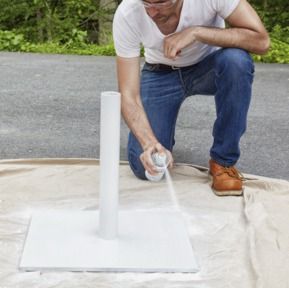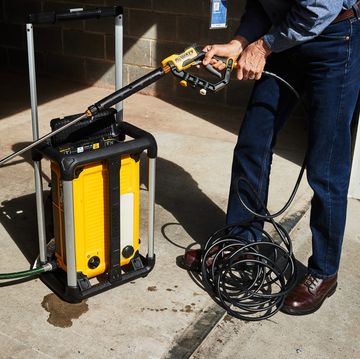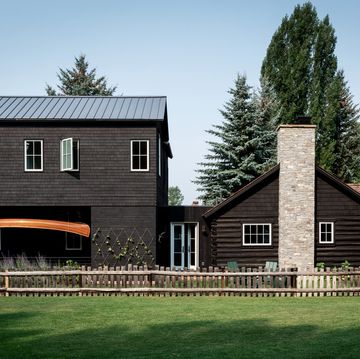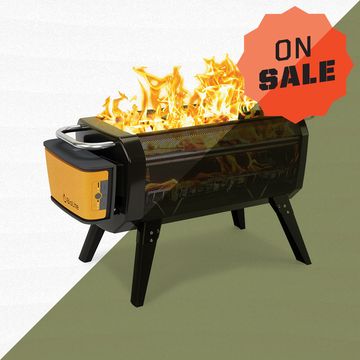There’s no quicker, more convenient way to paint small- to medium-size parts and projects than with spray paint. The challenge is how do you apply a smooth, even coat of paint without runs, drips and errors? Spraying paint is deceivingly simple to do, but difficult to perfect. Practice and experience certainly helps, but there are also several techniques that’ll help you spray paint like a pro.
Here, are our top 10 spray painting tips:
Start Smooth, Finish Smooth
Spray paint typically has a sheen that, when dry, reflects light and emphasizes any surface imperfections, including scratches, dents and nicks. So, before spraying on the final coat of paint, you must sand the surface smooth and then apply at least two primer coats. And be sure to sand between each coat. You can brush on the primer, but spray primer is much quicker.
Applying a primer and then sanding is especially important when spray-painting wood because the first coat of primer will raise the wood’s grain, creating a fuzzy, rough-textured surface. Sanding the primer with very fine sandpaper—180-or 220-grit—will knock down the raised grain and leave behind a smooth surface for the next primer coat, and then finally the paint topcoat.
You can use an orbital finishing sander, but hand sanding with a sanding block wrapped in sandpaper is just as effective. If you don’t want to buy a sanding block, make one from a short length of 1x3 or 1x4. And after sanding, be sure to use a tack cloth to remove any sanding dust before applying the next coat of primer or paint. Remember, the key to a smooth finished coat of spray paint is starting with a sanded-smooth, primed surface.
Spin Painting
A simple, yet effective way to spray paint smaller items is to put them on a lazy Susan turntable, which you can buy for as little as $6. Then slowly rotate the turntable as you spray on the paint. Just be sure to keep the can at a consistent distance from the piece to avoid drips.
Fast Finishing of Small Parts
To spray paint small fasteners, such as screws, nails, bolts, cup hooks and screw eyes, try this trick: Stick them into a sheet of cardboard. Stand the cardboard up—preferably outside—and then spray on the paint.
For Bigger Projects, Use a Big Dropcloth
To capture overspray when spray painting larger projects, don't waste time taping together sheets of newspaper; they’ll only rip and fall apart as you paint. Instead, spread out a large plastic or, better yet, canvas drop cloth. That’ll provide plenty of protection from overspray as you apply the paint.
Do a Spray-Pattern Test
Before spray-painting the workpiece, shake the can until you hear the mixing ball inside bouncing around. Then shake well for at least 90 seconds. Now, and this is important, test the can’s spray pattern by spraying some paint onto a large piece of cardboard or scrap plywood. Once you see the spray pattern, you can adjust your technique and determine how far away from the workpiece you must hold the can.
Also, when spray-painting large or long items, start spraying an inch or so off the near edge of the piece, and continue spraying all the way across and off the far edge. Stay a consistent distance from the piece and hold the can parallel to the surface, don’t sweep your arm back in forth in an arc.
Use Tough Paint for Demanding Jobs
When you need a high-gloss coating that resists rust and chemicals, take a tip from the auto-body industry and step up to a 2K (two-component) spray paint. Like epoxy, the resin and solvents stay separate until you’re ready to paint.
Clean and Prep
Another great crossover from the auto-body industry is rubbing compound that cleans and abrades the surface at the same time. It’s great for buffing out scratches, but can also be used to prep the surface prior to spray painting. Just be sure to clean off any compound residue before painting.
Hide Knots with Shellac
To prevent sticky, resinous tree knots from bleeding through a topcoat of paint or varnish, spray on a coating of clear shellac or a white primer that contains shellac. (Shellac is a natural resin that’s secreted by female lac bugs in Southeast Asia.) It does an excellent job of sealing tree knots and also locking in odors and stains.
Hide Grain With a High-Build Primer
Rough, grainy textures in wood tend to show through most spray paints, leaving you with a textured surface that still looks not-quite finished. If you’re painting something like fir plywood, use high-build primers, which are often labeled: filler and sandable primers. They’re thicker, but still dry rapidly, so that you can apply multiple coats in a relatively short period of time. If you really want to cover up the grain, use a thick spray-on coating such as Plasti Dip, which is an aerosol rubber coating.
Add a Handle for Better Spraying
If you’ve got a lot of spray-painting to do, or are spraying a large project, consider using a spray-can tool, such as the Can-Gun 1. This cleverly designed accessory is a pistol-grip handle that clips onto a spray-paint can. Once attached, it provides a much more comfortable, natural way to spray paint, and it eliminates finger fatigue and cramping.

Roy Berendsohn has worked for more than 25 years at Popular Mechanics, where he has written on carpentry, masonry, painting, plumbing, electrical, woodworking, blacksmithing, welding, lawn care, chainsaw use, and outdoor power equipment. When he’s not working on his own house, he volunteers with Sovereign Grace Church doing home repair for families in rural, suburban and urban locations throughout central and southern New Jersey.
Joe is a former carpenter and cabinetmaker who writes extensively about remodeling, woodworking, and tool techniques. He has written eight books and is a contributing editor to Popular Mechanics. He also appears on the Today’s Homeowner TV show, and co-hosts the weekly Today’s Homeowner Radio Show. Joe writes from his home in Roxbury, Connecticut.














